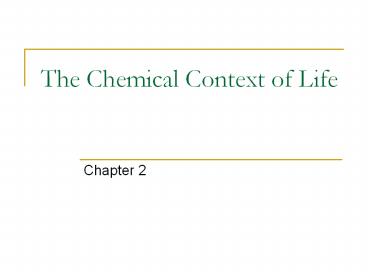The Chemical Context of Life PowerPoint PPT Presentation
Title: The Chemical Context of Life
1
The Chemical Context of Life
- Chapter 2
2
The Structure of Atoms
- An atom is the smallest unit of matter that is
unique to a particular element. - Atoms are composed of three particles
- protons (positive charge, nucleus, amount gives
atomic number) - neutrons (no charge, nucleus, these added to
protons yields atomic mass) - electrons (negative charge, orbitals, amount is
equal to protons, mass is negligible). - Atomic numbers and mass numbers give idea of how
substances will react.
3
Isotopes
- Atoms with the same number of protons but a
different number of neutrons are called isotopes - (Ex. Carbon can exist as C-12, C-13, C-14)
- Some radioactive isotopes are unstable and tend
to decay spontaneously giving off particles and
energy. - This decay into more stable atoms occurs AT A
PREDICTABLE RATE. - These characteristics makes isotopes good to use
for radioactive dating, for use as tracers to
follow the path of an atom in a series of
reactions and for use in diagnosing disease. - see pages 30-31 for scintillation counters,
autoradiography, and PET scans
4
Electrons Energy Levels
- If outer orbital (valence shell) is not full of
electrons, an atom has 3 choices - give up extra ones to fall down to the next
level, - gain more to fill up the current level,
- share what they have with another atom.
- Loss or gain results in ions (charged atoms)
opposite charges attract and give ionic bonds - Sharing of electrons results in covalent bonds
- Electrons differ in their amounts of energy the
closer to the nucleus, the less potential energy
that it has - Electrons can move to a higher energy level, but
will move back to original position - releases energy gained when this occurs.
5
Energy Levels of an Atoms Electrons
6
Energy
- ENERGY IS THE ABILITY TO DO WORK.
- Potential energy is the energy that matter stores
because of its position or location. - Kinetic energy is energy of motion.
- Need activation energy to convert potential
energy to kinetic energy.
7
Molecules
- Molecules are formed when two or more atoms bond
together may be either one element or different
elements - If consist of two or more different elements in
proportions that never vary, then is referred to
as a COMPOUND - (Ex. Water)
- If two or more elements are simply intermingling
in proportions that CAN vary, then it is called a
MIXTURE. - (Ex. Water and sucrose)
8
Bonds
- Any atom that has lost or gained electrons is
called an ion - if lost electrons, will be positive (cation)
- if gained, will be negative (anion).
- When a cation and an anion are attracted, they
form an ionic bond. - Covalent bonds are formed when electrons are
shared between atoms one pair shared gives a
single bond, two pairs gives a double bond, three
pairs, a triple bond.
9
Ionic Bonds
10
Sodium Chloride Crystal
11
Covalent Bonds
- The attraction of electrons to an atom is called
electronegativity. - The more electronegative an atom, the more a
shared electron is pulled towards its nucleus. - If two atoms are of the same element or of the
same electronegativity, the pull of the electron
is equal and the bond is a NONPOLAR covalent
bond. - POLAR covalent bonds form when one atom is more
electronegative than another thus, the electron
is pulled closer to the atom and the electron is
not shared equally. - The atom with the greater electronegativity will
be slightly negative because the electron spends
more time around its nucleus. The other atom has
a slightly positive charge.
12
Covalent Bonding
13
Water POLAR COVALENT BONDING
14
The Importance of Weak Chemical Bonds
- Examples
- Ionic bonds
- Hydrogen bonds pg 36
- Van der Waals Interactions pg 36
- All of these are weak, but the advantage is that
the contact between molecules can be brief the
molecules come together, respond, then separate.
15
Hydrogen Bonds
- These occur between molecules (or even in
different parts of the same molecule). - They are weak attractions between an
electronegative atom and a hydrogen taking part
in a second polar covalent bond. - Individually, hydrogen bonds break easily
collectively, they work to stabilize structure. - Ex. DNA molecule, water
16
A Hydrogen Bond
17
Van der Waals Interactions
- Occur when atoms and molecules are very close
together. - Due to movement of electrons and productions of
hot spots within a molecule that make it stick
to another molecule or atom.
18
Molecular Shape Function
- Molecules have characteristic sizes and shapes.
- Shape determines recognition and response to
other molecules.
19
Molecular Mimics
Morphine affects pain perception and emotional
state by mimicking the brains natural
endorphins. The boxed portion of the endorphin
molecule is recognized by receptor molecules on
target cells in the brain. The boxed portion of
the morphine is a close match.
20
Chemical Reactions Reaching Equilibrium

